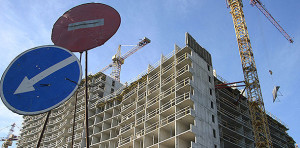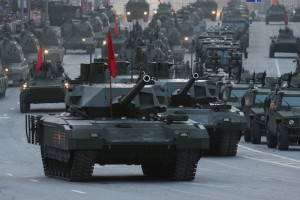
The construction of new apartment buildings in major Russian cities has always been a focus of attention for the Kremlin. Stalin’s “Barracks Baroque“, Khrushchev’s five- and nine-story apartment blocks, the Brezhnev-era bearing-wall buildings, and, finally, the present-day “elite” housing that is being built and sold to the population at an ever-increasing rate, all gave Russian citizens a dream that, if not them, then their children will be able to enjoy life and raise their kids in comfortable, spacious, and, most importantly, their own apartments. Those in the Kremlin have always understood that the regime’s “stability” is underpinned not only by fridges that are full of food and by military parades on television, but also by warm housing for their viewers.
But the economic crisis that has been engulfing the country over the last two years thanks to Putin’s foreign policy efforts, which are supported by the militant majority, is having a serious impact on the housing market. According to the Russian Statistics Service, the commissioning of new housing in 2015 has slowed down. The figures so far are not too frightening, but it must be taken into account that the construction industry is fairly inert: it takes an average of two years to construct an apartment building; the expensive construction equipment depreciates even slower; while construction materials have been purchased in advance, so the current price rise is not relevant. The high profitability of construction projects in recent years also plays a role, as developers can now afford to wait out the profit decline.
Meanwhile, figures from the Russian Statistics Agency for 2014 (the official statistics for 2015 are not yet available) point to the beginning of a crisis on the housing market. Thus, in 2014 housing construction financed by the regional and local budgets fell by 22.3 percent; the commission of housing financed by mortgages decreased by 4.2 percent; unfinished construction grew in numbers. It must be borne in mind that world oil prices–Russia’s main source of income–only started falling in the summer of 2014, while the value of the ruble collapsed at the end of that year. That same year, the Russian Central Bank raised the interest rate to 17 percent, making mortgages unaffordable.
Statistical data on the issued mortgages points to a more than 30 percent decline in the number of mortgages in 2015. These figures correlate with data from the banks: the state-owned Sberbank and VTB24, which between them control 75 percent of the mortgage market, noted a decrease in the volume of issued mortgages by, respectively, 28 and 43 percent. It is not surprising therefore that, according to the polls conducted in February 2016, 83 percent of Russians have no plans to improve their housing conditions. At the same time, debt arrears in mortgages are growing: in the 4th quarter of 2015 (as compared with the same period in 2014) they increased by 43 percent.
As a result of the falling demand, construction companies are finding themselves in trouble. For example, Donstroi, together with VTB24, is trying to attract customers by lowering the mortgage rate, while the PIK Group of Companies had to transfer 40 percent of its shares to the Moscow Credit Bank and the aforementioned VTB. Rossiiski Kapital, another bank bankrupted in the past and transferred under the state control, has been called on to save one of Russia’s largest construction companies, SU-155, that has 63 unfinished projects in 11 Russian regions, although Construction Minister Mikhail Men spoke out against its bankruptcy less than a year ago.

Given that in January 2016 real disposable household incomes in Russia fell by 52.2 percent compared to December 2015, and that 49 percent of Russians complained of a worsening financial situation, other bankruptcies in the housing sector are to be expected, as people have no money to buy apartments.
Starting in the mid-2000s, Putin promised to raise the people’s prosperity, including by improving their housing conditions. Today, his sidekicks are advising the people to tighten their belts and wait out the crisis. As happened before in Soviet history, young families risk not being able to have their own well-furnished apartments. Their children, however, are guaranteed military parades on Red Square.





